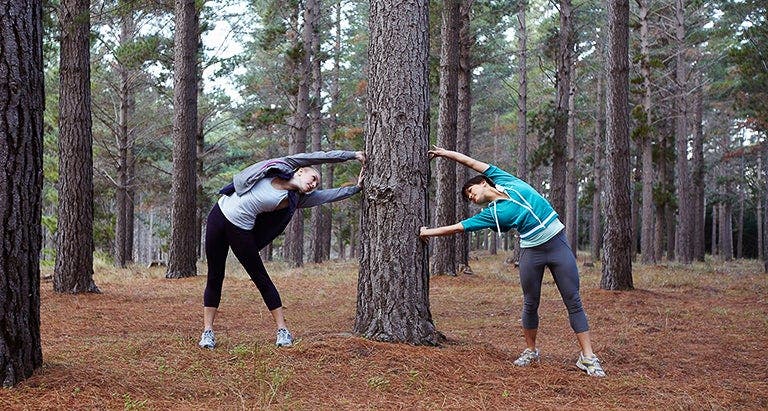How to Create a Movement Routine


Routines are powerful. Once you have a solid schedule — the smoothie you start every morning with, the route you drive home from work every night — sticking to it becomes easier than straying from it.
Often, this is a positive: “Established routines are so helpful because they make a behavior more automatic,” explains Michelle Segar, Ph.D., a scientist who studies motivation and the author of No Sweat: How the Simple Science of Motivation Can Bring You a Lifetime of Fitness.
Routines are particularly beneficial when they involve healthy behaviors, like movement, too. But when it comes to exercise, it’s all-too-easy to choose the couch over the treadmill after a long day of work, right? Fortunately, there are ways to sneak fitness into your everyday schedule. Over just a few weeks, it’ll find a spot in your daily routine — and just as you wouldn’t skip your go-to coffee shop every a.m., you won’t want to forgo your sweat session either. Here, six ways to make movement a routine.
Pick a Cue
Every morning, you know it’s time to wake up when you smell coffee brewing. Every night, you brush your teeth and wash your face. You can train yourself to do something similar with exercise — you just need a cue. A study out of the University of Iowa found people are more likely to stick to a workout routine if they have a signal that it’s time to get moving (this of this kind of like a Pavlovian response). Find your own cue — your alarm goes off in the morning and you head straight out for a walk, you watch your kids’ bus pull away and you pop in a yoga DVD — and daily activity will be part of your schedule without a second thought.
Reframe Your Thoughts
A study in The Journal of Consumer Research found simply switching your inner vocabulary from “I can’t” to "I don't” (“skip my daily workout,” for example) helped people stick to their goals. Saying “don’t” instead of “can’t” helps you feel more empowered, like decisions are within your control, the researchers say.
Plan Accordingly
“Habits are about minimizing barriers and maximizing opportunities. We often make things that are really easy far more difficult,” says Drew Ramsey, M.D., chair of the American Psychiatric Association’s Council on Communications. For example, you may love the gym across town for its sauna and smoothie bar, but those perks don’t matter if it’s 30 minutes out of your way.
Make things easier: If you want to join a gym or fitness studio, pick one close to your house or your work. If you want to start going for a family bike ride on Sundays, take one afternoon beforehand to tune up everyone’s bikes, gather all the gear, and plan out a route. If you want to start swimming but don’t have a suit, order one online instead of trying to find time to go to the store.
Move in the Morning
“Getting up and moving immediately bypasses any opportunity for excuses to be made or challenges to arise,” says Antonia Baum, M.D., a sports psychiatrist in Bethesda, MD. If your mind isn't awake enough to find an excuse, you’re going through the motion automatically — and it’s that autonomy that leads to routine, she adds. Not everyone’s schedule allows for this, but keep in mind that the last item on your to-do list typically get bumped when other obligations come up.
Find a Buddy
“We like to please others, so including people in your habits around movement can help ensure you stick to the routine,” says Ramsey. “If you’re tired and try to bail on the gym, that now has meaning for both you and your partner. Use your guilty conscious to your benefit.”
Bonus: People who sweat with a partner work out more often than those who stay solo, according a study in The British Journal of Health Psychology.
Set a Goal
Once you choose your daily movement, pick something to work toward — a 5K in the spring or a goal of being able to do 20 pushups by the end of the month. “Having a finish line keeps you accountable and on schedule. If you are walking a race in 45 days, it suddenly does matter if you skip just this one day of training. You’re more likely to stick to your routine,” Ramsey says.
